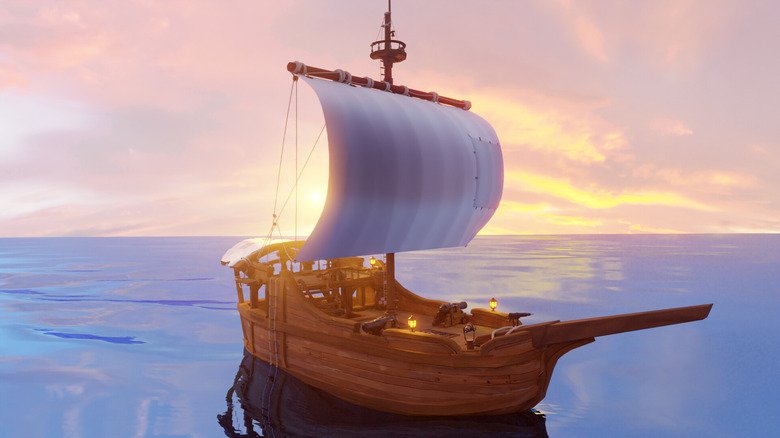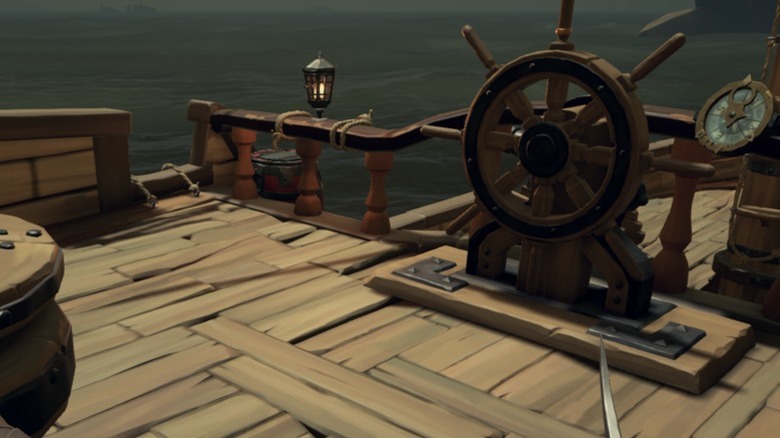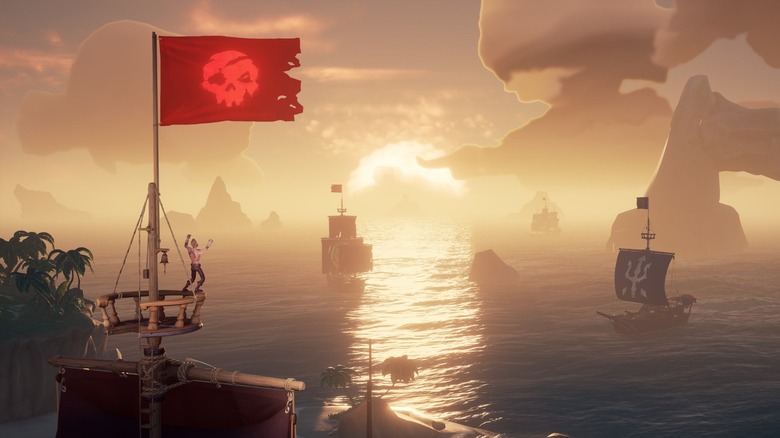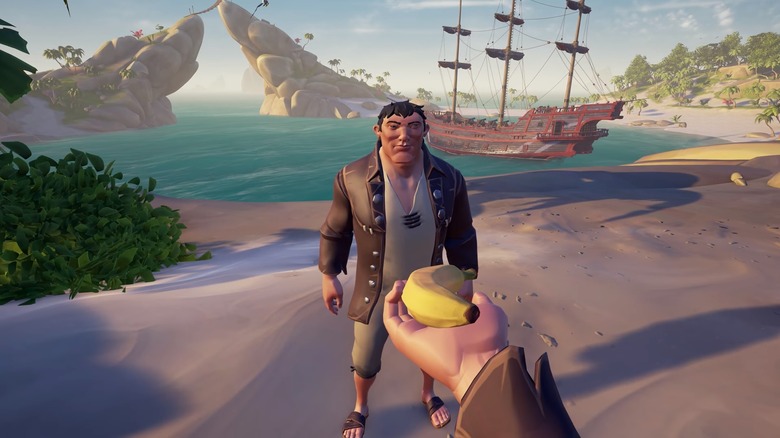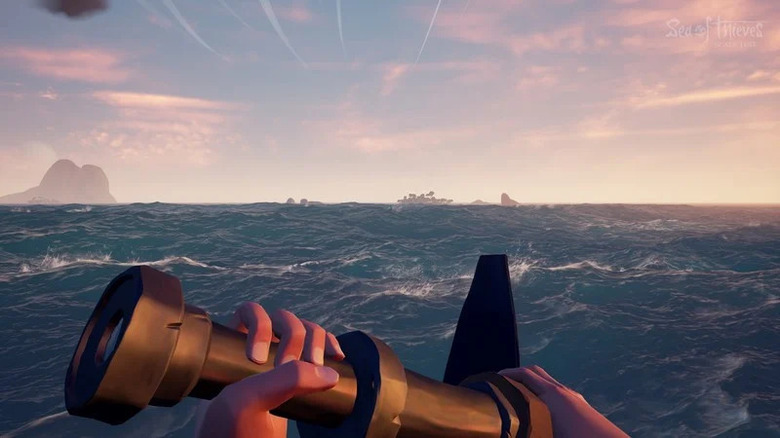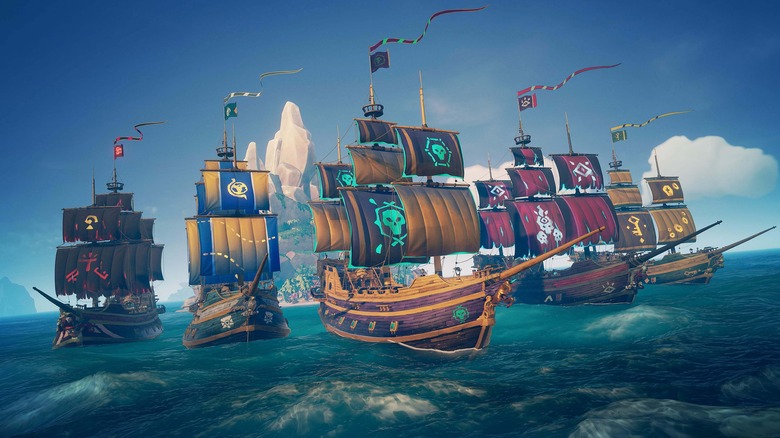What You Should Know Before Sailing Alone In Sea Of Thieves
Developed by famed developer Rare and released exclusively on the Xbox One and PC, "Sea of Thieves" was an ambitious project that aspired to capture the thrill and perils of pirate life. In the lead-up to its 2018 release, the game was highly anticipated in part because of its open-world concept and versatile mechanics that allowed players to essentially form their own path. Unfortunately, "Sea of Thieves" underwhelmed players with its lack of content when it was finally released. However, the game has since experienced a resurgence due to its consistent updates — not too dissimilar to that of "No Man's Sky" — and has become quite popular among its niche but dedicated fanbase.
With the game now being virtually free for GamePass subscribers, it's only natural that many gamers will at least give "Sea of Thieves" a try out of curiosity. Because it's a multiplayer title, players will have the opportunity to squad up with others, but this might be a struggle for some who are just getting into the game and aren't yet ingrained in its community, forcing many to go at it solo. How can solitary players navigate the seas in "Sea of Thieves" and get the most out of their experience? Here's everything you should know about playing alone in "Sea of Thieves."
Stick to a small ship
A pirate is only as good as their ship. In "Sea of Thieves," you will have three ship types to choose from: the Sloop, the Brigantines, and the Galleon. The Sloop is the smallest ship in the game, suitable for up to two players. It lacks impressive stats like durability, but it makes up for it with maneuverability and a quicker anchor. The Brigantine is a medium-sized ship, optimal for a three-pirate crew. Out of the three ships, the Brigantine is the most balanced. Last but not least, there's the Galleon, the biggest ship out there. Perfect for a crew of four, the Galleon is the most durable and can hold the most loot. However, being a bigger ship, its maneuverability is limited.
If you're sailing in "Sea of Thieves" on your own, it's probably best to stick to a Sloop. While it's not the strongest ship out there and won't hold the copious amounts of loot that a pirate desires, it's a much easier ship to operate on your own (players are responsible for steering the ship and controlling its sails). The Sloop isn't the most glamorous or intimidating ship out there, but its low-maintenance and responsive controls mean that you can make up for your lack of a crew quite easily.
Load up on planks
Though the game offers players the opportunity to play solo, "Sea of Thieves" is still primarily a multiplayer experience. As such, many other players will also be exploring the in-game world in search of virtual treasure. While all of them aren't necessarily hostile, some groups will attempt to ruin your day by either stealing your loot or just griefing you. To be on the safe side, it's probably best to stock up on Wooden Planks.
For the uninitiated, your ship can be damaged in "Sea of Thieves," be it from you crashing into things or being attacked. When your ship takes damage, holes will appear below deck on it will begin to take on water. Wooden Planks are used to seal these holes to prevent the flow of water into your boat so you can go about removing said water and keeping your ship from sinking. If you're solo, it's likely you'll be a bigger target for groups of players who don't want a fair fight. It's probably best to stock up on as many Wooden Planks as you can find in order to be prepared for any such confrontation.
Don't choose the Flag of the Reaper's Mark
As with any ship you first acquire, it's likely you'll want to customize it to your liking. Almost everything can be customized on your ship, be it the décor, sail, or color scheme. Another thing you can do is change the flag that sits atop your crow's nest. However, there is a huge caveat to this process: flags also determine the type of game you want to play and offer changes in how you interact with the world. One such example is the Flag of the Reaper's Mark.
Visually, it's a really cool-looking flag. Sporting an almost luminous skull over a red backdrop, it's about as pirate-y as they come and will surely be a tempting choice for its aesthetic alone. However, it's not worth it. The Flag of the Reaper's Mark offers one particular function that could make searching for treasure quite difficult — it marks your location on the map to other players. For this reason, popular "Sea of Thieves" content creator Captain Falcore has dubbed it the "Piñata Beacon" because it is an invitation for others to come attack you.
This is exactly the type of attention you don't want if you're sailing by your lonesome. For many, flying the Flag of the Reaper's Mark will be an outright challenge and whatever crews are in your server will likely try to battle you as a result. Mind you, you have no crew or backup. So inviting a confrontation with other players is probably not in your best interests.
Don't collect bananas
When you begin your session in "Sea of Thieves," you will be spawned on an outpost. While on this outpost, you can scavenge all of the wooden barrels on it for resources to aid you on your journey. These resources include the aforementioned Wooden Planks, bait for fishing, and fruit to replenish health. There are many different types of fruit in the game ranging from mangos to coconuts, all of which offer varying replenishing effects to the player should they consume them. However, there is one fruit you should absolutely not waste your time on, and that is bananas.
Unlike their real-life counterpart, the bananas in "Sea of Thieves" don't offer much in the way of nourishment. Bananas only restore a lowly 20 health points should you consume one. They are a waste of cargo space that could be used for more effective types of resources such as munitions, fruit that works, and wooden planks to help fix your ship.
Avoid bananas at all costs! No, seriously. Don't stock them.
Always mind your surroundings
Yes, we've spent a lot of time talking about how you should avoid confrontations with other players when you're on your own in "Sea of Thieves," but we're gonna keep saying it. You are all alone on this journey. Nobody is with you to help you out, and it's likely neutral players sailing around won't come to your aid should get embroiled in any such fight. Therefore, it's important to mind your surroundings to help see threats before it's too late.
The best method of doing this is moving up to your crow's nest to get a bird's eye view of everything going on around you. Then, select your Spyglass and do a 360-degree sweep of your surroundings to make sure there are no other ships coming in your direction. If you see any, it's probably best to set your sail to full mast, raise your anchor, and hightail it out of there. It's also important to notice the presence of any Skeleton Ships as well, AI-controlled ships that contain plenty of loot but are notoriously hard to bring down. Skeleton Ships won't seek you out necessarily, but they will engage you with full force if you get too close.
Set your sail to half mast
Sailing a ship isn't a matter of simply steering the thing. Even in your tiny Sloop, you will still have things to do. This includes shifting and angling your sails, as well as dropping and raising your anchor. In "Sea of Thieves," things can go wrong pretty quickly. One second, you're enjoying the sparkling, foamy ocean with the wind rushing through your avatar's wavy locks. The next, you're frantically trying to avoid a sharp rock that can do your ship some serious damage. In order to avoid this, you can simply set your sail to half-mast.
Your sail is what's responsible for how fast your ship travels in "Sea of Thieves." For instance, a sail set to full-mast that is angled to catch the wind directly will move rapidly. While you don't want to be moving at a snail's pace, it's probably in your best interests that you aren't going full tilt at a time when the waters are dangerous and every second counts. Setting one's sail to half-mast will avoid any such calamity while also allowing you to move efficiently across the seas.


